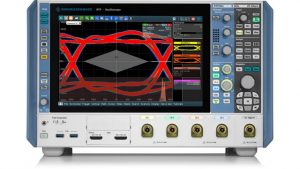
News
R+S scope hits 8GHz and a million waveforms per second

Maximum sample rate is 20Gsample/s, maximum memory is 2Gsample, and it has a 12in display.
Called ‘RTP‘, it includes real-time compensation for transmission losses between the signal source and the oscilloscope (de-embedding). “The advantage is that the oscilloscope is still extremely fast even with signal correction activated,” said R+S, “and, thanks to its digital trigger architecture, it can precisely trigger on compensated signals.”
A cascade of signal path blocks can be defined for de-embedding, with individual blocks are described by S-parameters that can be derived from simulation or measured with a vector network analyser. The de-embedding software automatically calculates the correction filter for the overall system response.
Hardware acceleration is provided for range of analysis functions. According to the firm, mask tests, histograms and frequency domain analyses can be performed at high speed with high statistical reliability.
Not just a scope
16 logic channels, four voltage channels and four current measurement channels are available in addition to the analogue oscilloscope channels.
Protocol analysis of serial bus interfaces is included, as is spectrum analysis and signal analysis.
Inside, the firm has created its own analogue ASICs for the signal path, and multi-chip modules to mix different technologies. For example: “As a critical component for both signal integrity and ruggedness, the termination resistor is manufactured with in-house technologies and laser-trimmed for precise input matching.” >6.5 ENOB (effective number of bits) and >45dBc SFDR (spurious free dynamic range) is claimed. Vertical input sensitivity goes to 1mV/division without measurement bandwidth limitations.
For the RTC’s digital asic, it claims: “High acquisition and processing rate supports fast detection of rare signal faults and ensures a responsive instrument during operation. The asic is capable of running multiple parallel processes, which dramatically reduces blind time.”
The firm sees it being used in markets including defence, automotive, industry and telecommunications, for development debugging of systems with different signals, such as high-speed buses (USB, PCI Express, MIPI), multi-channel RF interfaces (radio or radar), DDR memory interfaces, power management and control and programming buses (I2C, SPI).
One last thing R+S emphasises is almost silent operation, “thanks to the sophisticated cooling concept and the silent fans”.
In the pipeline for 2018 are more hardware options, including a generator module with two analogue and eight digital channels, and a 16GHz differential pulse source.
Models with higher bandwidth are planned for 2019, adding to the 4, 6 and 8GHz versions announced today.
The first public demonstration of the RTP family is scheduled for the International Microwave Symposium (IMS2018) in Philadelphia this week.